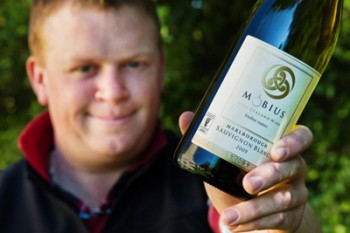
The guys over at the New Zealand Wine Company (NZWC) have come up with the novel idea of branding their Mobius Sauvignon Blanc with the carbon footprint each glass of wine leaves on the world. This milestone in certification is just one step the company has been pursuing in its quest for sustainable management within the country’s wine industry. The beauty of this certification is that each bottle will be adapted to its prospective market, meaning the emissions impact will vary from country to country.
For wine aficionados, this is one more aspect to consider among the various facets wine plays on the senses and on deciding quality in a wine – the environmental damage wine production and shipping of the wine causes. These effects can severely diminish a winery’s credentials if the labeling takes off and exposes the darker underside of winemaking’s belly.
Mobius, whose name comes from the highest peak of hills in the area of its production, will be the first wine to label its carbon emissions based on a 125ml glass of wine. The emissions are calculated to reflect transportation and refrigeration costs per distance the wine travels. So, local labels will reflect a smaller carbon footprint whereas wines exported out of the country will have a larger footprint. An example would be the relation of one bottle of wine produced equating to roughly 7.5 miles traveled in a car after shipment to the UK.
Mobius is also the first wine certified by the UK’s Carbon Trust, an organization that promotes universal awareness of carbon emissions on labels to influence consumer choice. The organization announced earlier that products carrying their independent label will soon top roughly $3.5bn USD per annum.
There are those who find the methodology of Carbon Trust misleading, though. Mike Berners-Lee, author of How Bad Are Bananas? The Carbon Footprint Of Everything, says there are real problems with the system in place, concluding that there are too many variables among products to make a viable comparison and establish a universal system of grading. A review commissioned by the UK government organization Defra (Department for Environment, Food and Rural Affairs) seems to suggest the same conclusion.
Regardless, those in favor of the labeling feel that the Carbon Reduction label is there to help consumers make an informed decision. Purchase of products carrying the label shows support for the companies trying to make a difference by working towards a sustainable investment.
The Wine and Spirits Trade Association likes the idea of the label but cautions a consistent approach, so that methodologies are the same across the wine industry. Many companies are taking their own steps to produce carbon emission calculators. The conflict that arises is how each winery approaches the calculations and applies it to their own labels. Without regulation, wineries are not held to any standards and can basically apply an approach that boosts their own ratings.
Mobius Sauvignon Blanc is expected to first hit the Australian market with the Carbon Reduction Label in early 2011.


Speak Your Mind